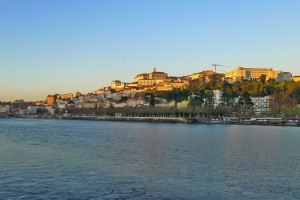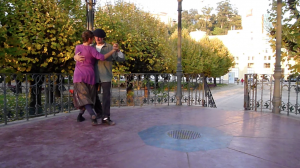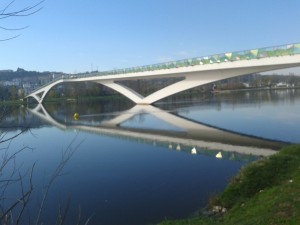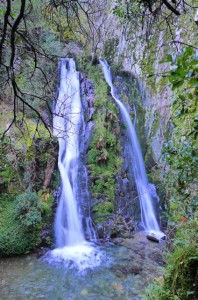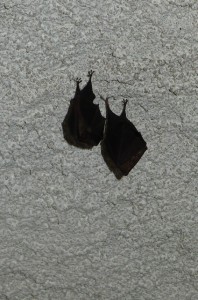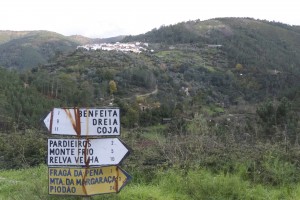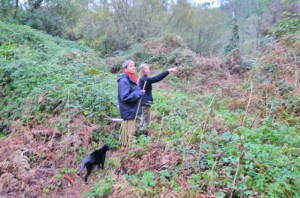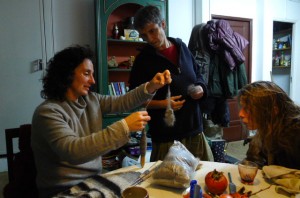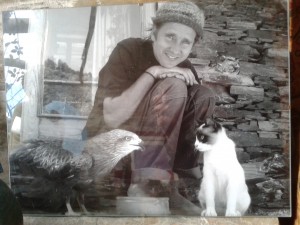Coimbra
We arrive in Coimbra in time to catch the Tango lessons at The Stream, a dance school on the northern outskirts of the city. We meet Hélio and Sónia who teach there and are invited to join their classes as guests. Very nice, clear teaching, and we enjoy seeing them teach the three different levels – beginners, intermediates and advanced. The best way to find out about how someone teaches is to go to their beginners’ classes.
Frank and I’ve been practicing quite a bit in the last month, wherever we could find a suitable space to dance, and it is starting to show. We are both more grounded and fluid with each other in our dance. We found a lovely bandstand by the river in Coimbra:
It’s lovely to have the time to study, and nice to meet new teachers. We are on the look-out for a new teaching couple to join the Tango Mango next summer.
The bandoneon is also getting a good number of outings per week, and some of the pieces are almost ready to be performed. Very satisfying!
We’ve joined a group of campervans by the nautical club in Coimbra, right next to a swimming pool. People in campervans seem to be a really quiet lot on the whole; they keep themselves to themselves. Often you don’t even know if anyone is in, and contacts rarely go beyond saying hello and exchanging a few bits of useful info about the locality. So I am surprised to see a beautiful parrot in a cage hanging off a tree just outside one of the campervans. The bird and I have a nice 5-minute conversation of fluting sounds, and then he closes his eyes. Maybe I whistled him to sleep.
The city is just a stone’s throw away, across a colourful pedestrian bridge. 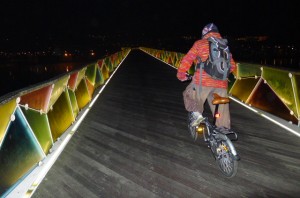
The last few days the weather has been extraordinary. Cold, starry nights with a beautiful full moon are followed by bright sunny days where it’s hot in the sun and really cold in the shade. We’ve been busy loading up all available storage with wood and kindling, just in case we don’t find so many trees where we are going next. We have a good week’s worth stashed away now.
Posted in Uncategorizedwith 1 comment.
Fraga da Pena
For more photos of this beautiful waterfall, including a little video clip of it, go to our flickr album. Believe it or not, we went swimming in this!!!
At the heart of this community runs a stream that tumbles down the hill between Pardieros and Benfeita in a series of waterfalls called Fraga da Pena. It is recognized as a place of outstanding beauty. As you walk up to the waterfalls, you pass by a few old mills and a series of leats and other constructions in stone – steps, benches and tables mainly. Some of them look very old. We don’t know the history of this place – did people use the tables and benches there for some work, and if so what kind of work, or has this been a tourist spot for a long time? The waterfalls have a sacred feeling to them, maybe it was a place where people came for some kind of healing? Why is it called Fraga da Pena? Hearing some of the personal stories, one can certainly say that this valley offers its fair share of pain…
I haven’t quite got to be bottom of what makes this community tick, and somehow I get the feeling that this stream, and especially the waterfall, holds the key to the answer.
Another special place in this landscape is the church just below the waterfalls, called Sra. das Necessidades. As it has a fairly flat car park, we park up there for a few nights and enjoy the sunshine in the morning. We use the pump in the yard to have some bracing early morning ‘showers’ – it is getting rather cold… One day I go in search of a functioning toilet in the building nearby and I find a few bats hanging from the ceiling 
Posted in Uncategorizedwith 3 comments.
Valley of Pioneers
For the last ten days we have been in the valley of Benfeita and Pardieiros, meeting many extraordinary people. This place is worth seeing: a whole valley has been rejuvenated, woken up from the brambles and the fern, by a generation of foreigners who moved here, worked very hard and restored all the olive terraces and vineyards and old houses. Meet a few of the many protagonists:
Clio has just bought some land below Benfeita, where she lives in a tiny house with her cat Jebba. She has been in the area for a few years, and this is her second piece of land to recultivate. She already knows what it means to wrestle with brambles and she is doing it again!!! While we are there, we witness the arrival of a window – just in time for the winter! There is plenty of water running through her land – a stream at the bottom, and a mina (a water collecting hole in the wall) about 100mtrs from the house, but as yet no running water or electricity. A compost toilet is strategically placed a little away from the house in a spot with a beautiful vista. Having lived there for a couple of months, Clio has hacked her way through the brambles down to the stream, discovering a Levada on the way (a leat to water the fields and terraces). She has apple trees on her land but has yet to discover how many of them are still alive, as they are currently completely covered by brambles. The same goes for most of the olive trees. Rediscovering the land, its terraces, walls, stairways, fruit trees etc. is an adventure for Clio – every morning she can’t wait to get out there and get stuck in. In this way, she has already discovered a beautiful ancient Elderberry down by the river. She doesn’t want to use strimmers; she wants to do it gently and bit by bit. With every pulling of a bramble root, she connects with the earth and with the energy of the old man who once owned this land 25 years ago and loved it so much that he wouldn’t ever leave it, not even to spend Christmas with his children. Clio has a vision – she wants to share the beauty of nature with people and create a space where working on the land will be an experience of that beauty. She is also planning art exhibitions and music.
You can contact Clio by sending her an email. She also has a web site, but she’s been too busy working in the garden to update her pages. To see more photos of our tour of her land, click here
Lisa is also in her second stage of being in this area. She currently rents a house in the village, having moved there from a remote mountain farm. Lisa runs a business with Alpacas, taking people on trekking tours with them. She also works with children, including special needs, letting them connect with the animals whilst hiking with them. Alpacas are still fairly wild animals, their breeding hasn’t been tampered with as much as other domesticated species’, and their herd behaviour is very interesting, with a floating alpha structure. Lisa is passionate about her Alpacas and goes into every aspect of their uses. For example, they are great strimmers! If they graze a field that is overgrown by brambles, they will clear up to one meter into the brambles. Then you have to go and pull roots in that meter so they can do the next meter etc., leaving their pellets as perfect fertiliser as they go along.
This valley used to be a centre for the wool trade, and Lisa is in contact with one of the few remaining mills to have her wool carded. She spins and felts and runs workshops in crafts related to the wool, hoping to inspire people.
Click here to contact Lisa and connect with her Alpacas – she has a whole lot more photos on her facebook page. For more photos of our visit to the alpacas, click here
Kin and Beth have restored their house beautifully and are now settling down to have a family: they already have a delightful toddler called Gaia and another one is on the way.
On our last day in the village, it is Gaia’s first birthday and we go to congratulate her and the parents. On the windowsill we see an extraordinary picture of Kin right next to a bird of prey. They tell the story of this black kite arriving around the time that they conceived Gaia, and being around for the whole of the pregnancy. They called it Manu, and it got quite close to them, happy to be fed and touched, until one day it actually landed on Beth’s head, just days before she gave birth. After that, they didn’t see it again – it disappeared as suddenly as it had arrived.
Beth is an artist and Kin is a musician and a cranio-sacral therapist in training. Beth’s mother and Kin’s father live less than five minutes walk away, and until recently Beth’s brother and family lived in the valley too. They are surfers however, and the seaside and friends in Falmouth have called them back to the UK.
I ask Kin what brings so many foreigners, especially English people, to this valley? In a way, we are economic refugees, he says. If I could do in England what I do here, I would live in England. But in the UK, prices for land and property are prohibitive and building regulations are too restrictive. Looking across the valley, it is interesting to see that despite more lax building regulations, there are no great eyesores. Everyone is restoring their house with respect for the traditional structures and values, combined with their own creativity. This valley attracts a particular type of person; despite their strong individualities, they seem to share an ethic that respects nature and the traditional shape of the land.
Dick, one of the ‘oldies’, having been here for 16 years, looks across the valley. It’s incredible what has happened here, he says, the whole valley was covered in brambles 10 years ago, and now look at it, all the terraces cleared and the houses restored.
We have introduced just a few of the foreigners in this valley … there are many more.
Once a month, there is a work-day on someone’s land. Everyone gathers to help, and a huge amount gets done, while people connect and have fun. They share food and it seems that sometimes they party on into the night after a day of shared work.
Laura and her son Francisco (they are Portuguese) run the café in Pardieiros. The local community consists of predominantly retired people, their children having gone away to live in the cities. The café is a meeting point for them, and many go there to have lunch or share a cake and coffee with friends. Laura is an inspired cook: we have had many meals in the café, each one was exquisite. So much so that Frank has asked to go and work in her kitchen for a day, to see and learn.
The building has a large dance hall downstairs, overlooking the valley. This is where we taught our Tango workshop, and Frank and I have also been using it for practice most days.
If you would like to contact Francisco and Laura, either to book one of their delicious meals, or if you are looking for accommodation, click here
The locals welcome the estrangeiros with open arms. It seems they really appreciate the work these foreigners put into the land, and the effort they make to learn Portuguese. Kin tells us that many of the locals went abroad to work – in places as far away as Mozambique – and came back home to their village when they retired. They are very happy here, he says, and they relate to the estrangeiros because they themselves know what it feels like to be a foreigner.
For a few more photos of this chapter, including me scrambling up dangerous banks trying to rescue a precious oak branch for firewood, of a portuguese dovecote and of a sunset with moon, click here
Posted in Uncategorizedwith comments disabled.
